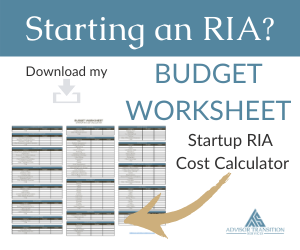The landscape of the wealth management industry is rapidly changing. The establishment of independent practices is on the rise and many of those firms are looking to ramp up their operations by focusing on inorganic growth. Mergers and acquisitions are at an all-time high and aging advisors have more exit opportunities than ever.
So, why do so many established advisors still not have succession plans in place? It’s certainly not for lack of options.
Over the past few months, I’ve spoken to a number of advisors who run successful RIAs and are on the hunt for client books to acquire. The conversations all touched on the same basic points: current demand outweighs supply, asking prices are inflated, and the distribution channels are often frustrating.
In terms of demand, as I previously stated, independent practices are gaining popularity. Inorganic growth has become desirable as a means of quickly increasing AUM and revenue. Firms are targeting the population of advisors that is set to reach retirement age in the next decade. The problem is, a large percentage of advisors nearing that age aren’t interested in change. Many of their businesses have been established for a long time, and their income streams have remained steady and passive. Their clients are loyal, happy, and easy to service. With ideal conditions such as those, it’s no wonder advisors aren’t interested in disrupting current operations, especially with an outright sale.
What aging advisors aren’t taking into consideration are the risks of complacency. Client books that are maintained, rather than actively and organically grown, will age over time and begin to lose value. A book worth $1 million in today’s supplier market could be worth significantly less in the future. An advisor who chooses to maintain that book in order to keep his/her income stream intact could be doing himself/herself a disservice in the long run. He or she runs the risk of that current income failing to cover the price decrease in book value, especially when taking into consideration the cost of actually working during that time.
For those wishing to sell, or at least entertain the idea of doing so, today’s market is ideal. In fact, a common complaint from prospective buyers is inflated list prices. Sellers are taking advantage of market demand and significantly over-pricing their books. As a result, many smaller firms are being disqualified from the race due to their size. Larger RIAs are snatching up the offerings, expanding rapidly, and drawing attention to themselves. The trend is making it difficult for startups to throw their hats in the ring.
With the industry landscape evolving to meet the needs of these startups, a number of new companies have popped up offering digital buyer and seller marketplaces. Examples include AdvisorBid, Succession Link, and RIA Match. While the concept is great, the feedback echoes the same sentiments I’ve already touched on. Too much demand and not enough supply. Sellers are inundated with offers and inquiries, and buyers are vying for attention.
So how do we tip the scales and even out the supply and demand? We help those soon to be retirement age advisors realize the importance of succession planning and give them the tools to seek out options. Succession planning does not have to mean selling a book of business outright. There are several paths to consider: external sales, internal sales, and teaming up with associate advisors.
External sales provide the broadest range of flexibility. Sellers can seek out buyers based on any number of criteria. It can be advantageous to them and their clients. This is where modern marketplaces such as AdvisorBid come in handy. You can create a profile, detail your situation, and let the buyers come to you.
On the downside, external sales generally involve a change in custodian and/or broker/dealer. Some advisors choose to participate in the transition for the sake of their clients. Others prefer that to be the sole responsibility of the new owner. Either way, the use of a transition consultant can be beneficial to all parties involved in the deal.
Internal sales are more convenient for buyers and clients. They don’t require a change of custodian or broker/dealer, and can often be done much faster. Sometimes the relationship between buyer and seller has already been established and makes the decision much easier.
The downside is that internal sales are often initiated out of convenience, or because of personal relationships, and are less likely to attract the top bidders that external sales can.
Associate advisors are hired and groomed to take over a book of business. An established advisor can mentor a younger advisor, teach him/her how to service clients a certain way, and slowly phase out of the picture. It’s the best solution for individuals who want to maintain some control and be sure they’re making the right decision.
On the downside, this method can take years and requires active participation. It is not a quick fix and often triggers even lower selling prices, though current income does continue for some time.
With the availability of different avenues, advisors can choose the path that best meets their needs. Ready to move on? Consider listing your book for sale. Try not to be overwhelmed by the response you receive. Set parameters and court those who meet your criteria. Get to know the people who want to benefit from your life’s work.
Don’t want to relinquish all control? Find some younger associates. Teach them. Learn from them. Work with them to put your clients at ease and ensure a successful transition.
Succession planning is important. No one can predict the future. What would happen if you died tomorrow? Who would take care of your family? Your clients? Your expenses? Chances are, you stress the importance of estate planning and retirement funding to your clients. Afford yourself and your business the same courtesy.




